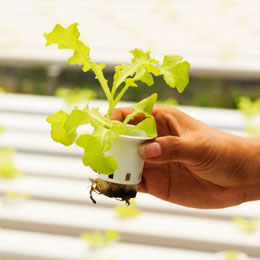Hydroponic nutrients are nutrients used in hydroponic solutions, to grow healthy and yielding plants. In this Buzzle article, we'll take a look at the several types of hydroponic nutrients, how they're used in solutions, and their advantages.

Considered to be one of the most efficient and productive ways to grow plants, hydroponic gardening is an indoor, soil-free style of growing plants. It is surprisingly an inexpensive style; it is said to cultivate healthy plants that yield large fruits and vegetables. In this method, a plant's roots are soaked in water containing essential hydroponic nutrients. Put simply, instead of soil, the plants use a hydroponic solution to grow. You can control the amount of nutrients and minerals, without bothering about external factors like rain, sunlight, etc. If you control the entire process properly, you can enjoy pesticide-free, naturally healthy fruits and vegetables throughout the year. So, to achieve hydroponic plants with the best yield, you have to understand what hydroponic nutrients are, their importance, and how to use them.
The Nutrients
Both, hydroponic and soil-grown plants, require 15 mineral nutrients to grow well. The top six elements―known as macro nutrients―include nitrogen (N), phosphorus (P), potassium (K), calcium (Ca), magnesium (Mg), and sulfur (S); these are required in large amounts. The remaining nutrients―called micro nutrients―are required in trace amounts. These are boron (B), chloride (Cl), copper (Cu), iron (Fe), manganese (Mn), sodium (Na), zinc (Zn), molybdenum (Mo), and nickel (Ni).
Preparing The Solution
Most nutrients are supplied in a concentrated form at different stages of plant growth. Young plants require a less concentrated nutrient solution, while mature plants need a stronger one. Nutrient strength is measured in cF (conductivity factor); more the nutrients in the water, more is the conductivity. To decide how strong the nutrient solution should be, note the water's background reading without adding nutrients. Tap water, for example, has a fairly high cF reading of 5; if you need to prepare a solution between 18 and 23 cF, this reading is important. Water can be added later to dilute the solution if necessary.
After preparing the solution, you must take into consideration its pH level, or basically, the acidity of the solution. This can be done using a calibrated pH meter. The ideal pH level should be between 5.8-6.3; a slight variance on either side is acceptable. However, if the pH level is very high, add a small amount of phosphoric acid to the solution, to bring it down.
Advantages of The System
One of the main advantages of this system is that the plants grow nearly 50% faster than regular soil-grown plants; they yield better as well. Soil-grown plants expand their roots in search of nutrients. Hydroponic plants, on the other hand, are automatically provided with all nutrients they need; they thus focus their energy on upward growth or in growth of important parts such as leaves, fruits, flowers, etc. The plants are supplied with a perfectly balanced, measured diet containing all necessary hydroponic nutrients required for healthy growth.
While preparing the nutrient solution, keep in mind, over fertilizing the plants can be as bad as under fertilizing them. Other additives that one can include in the nutrient solution include a plant booster, tonic, and a mixture of essential hormones and vitamins to assist root development and healthy plant growth.






 Considered to be one of the most efficient and productive ways to grow plants, hydroponic gardening is an indoor, soil-free style of growing plants. It is surprisingly an inexpensive style; it is said to cultivate healthy plants that yield large fruits and vegetables. In this method, a plant's roots are soaked in water containing essential hydroponic nutrients. Put simply, instead of soil, the plants use a hydroponic solution to grow. You can control the amount of nutrients and minerals, without bothering about external factors like rain, sunlight, etc. If you control the entire process properly, you can enjoy pesticide-free, naturally healthy fruits and vegetables throughout the year. So, to achieve hydroponic plants with the best yield, you have to understand what hydroponic nutrients are, their importance, and how to use them.
Considered to be one of the most efficient and productive ways to grow plants, hydroponic gardening is an indoor, soil-free style of growing plants. It is surprisingly an inexpensive style; it is said to cultivate healthy plants that yield large fruits and vegetables. In this method, a plant's roots are soaked in water containing essential hydroponic nutrients. Put simply, instead of soil, the plants use a hydroponic solution to grow. You can control the amount of nutrients and minerals, without bothering about external factors like rain, sunlight, etc. If you control the entire process properly, you can enjoy pesticide-free, naturally healthy fruits and vegetables throughout the year. So, to achieve hydroponic plants with the best yield, you have to understand what hydroponic nutrients are, their importance, and how to use them.